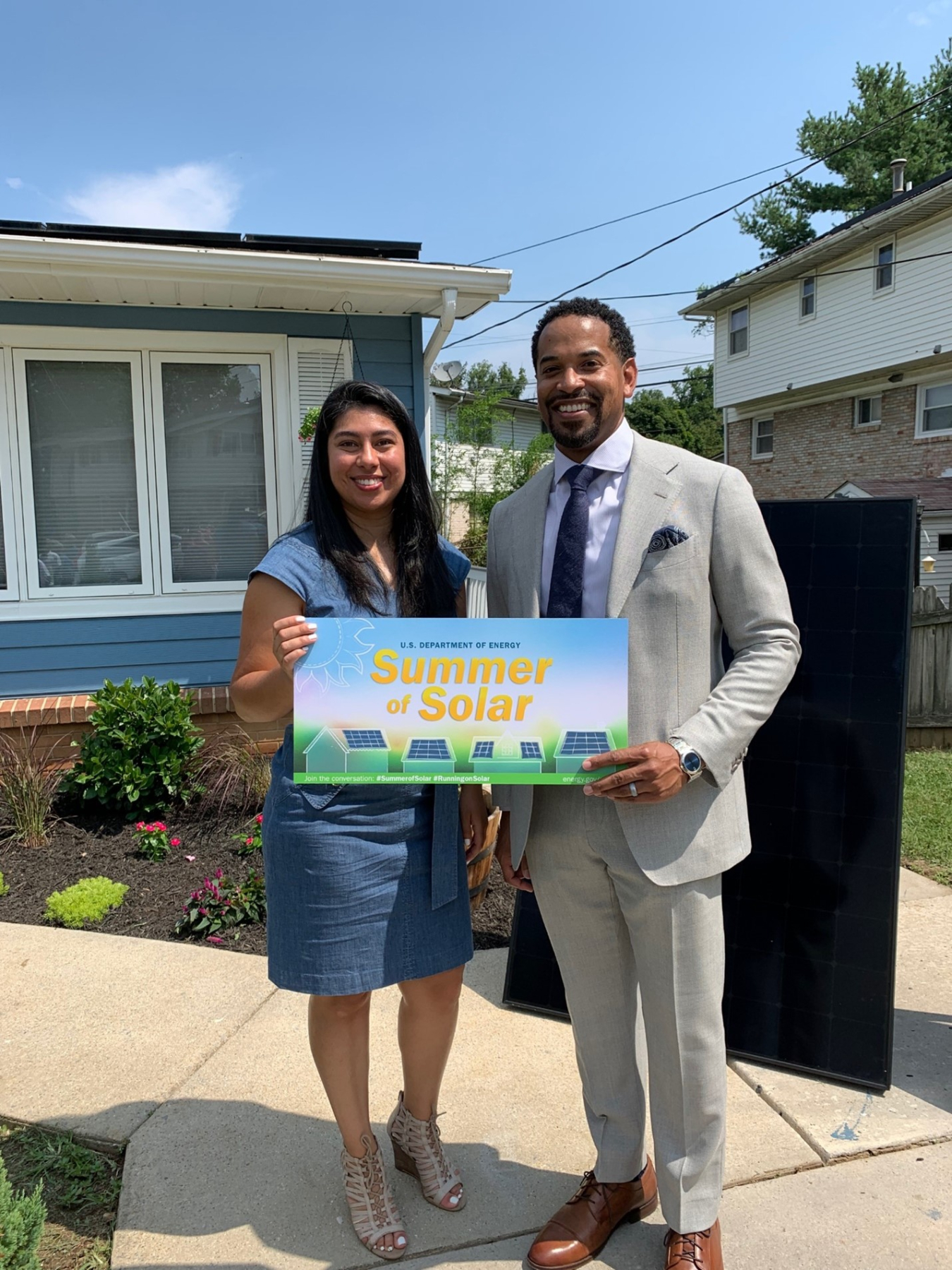The U.S. Department of Energy (DOE) is celebrating the Summer of Solar, and Secretary Jennifer M. Granholm kicked it off with a visit to Laura Morales’s home in Silver Spring, Maryland, for a firsthand look at her solar panels.
Solar Energy Technologies Office
July 29, 2021The U.S. Department of Energy (DOE) is celebrating the Summer of Solar, and Secretary Jennifer M. Granholm kicked it off with a visit to Laura Morales’s home in Silver Spring, Maryland, for a firsthand look at her solar panels. We caught up with Laura, who told us what the installation process was like for her.

What made you decide to “take the plunge” and go solar?
I was always open to the idea of being more energy efficient and helping the environment a bit more. The house was a fixer-upper, and it seemed like a good time to take the plunge.
I was able to calculate some savings from a monthly cost perspective and increase the value of my home.
What is the size of your system, and when did you install it? Who is your solar installer?
I have 26 SunPower 350-watt Signature Black panels, installed by Edge Energy in August 2018.
Laura has a 9.1-kilowatt system with a yearly energy production of 11,907 kilowatt-hours, offsetting 100% of her energy consumption.
Walk us through the process. What steps did you take to convert your home to solar power?
I did a ton of research, as there are a good amount of solar companies out there.
Two of the main things I focused on were the customer reviews and how the panels were created. That’s how I ended up working with SunPower. I requested a quote with SunPower, who connected me with Edge Energy.
The Edge Energy team came out and put together a quote for how much it would cost. They were wonderful and answered all my questions.
The purchasing process was smooth and easy; we talked through tax credits that I was able to qualify for, which I went on to use in purchasing panels.
Laura received the 26% federal tax credit, a $1,000 rebate from the state of Maryland, and will receive about $900 in solar renewable energy credits (SREC) each year.
How about the installation?
The set-up was easy as well. The biggest consideration was making sure that I was home on the day of installation. I also scheduled a state inspector to come out before inspections took place.
What challenges did you encounter along the way, and how were they handled?
It was around May or June when I signed the contract. We didn’t get the panels installed until September, and it was October when they were ultimately turned on. It was not a huge issue for me, as we had a lot of projects going on with the house. However, I could see how that could be an issue for others.
How did you finance your system—purchase, lease, a solar power purchase agreement?
I received a loan, plus a cash initiative related to the solar investment tax credit, or ITC.
Laura took out a 20-year loan that allowed her to take advantage of the ITC up front and lower the cost of her system.
How has the solar system changed your energy costs?
Before I had the system installed, I was paying roughly $250 for electricity in the summer. Now I’m paying $190 for the panels and like $8.50 for the utility. In addition, I receive the SRECs every quarter.
Laura saves about $50-$60 each month on her energy bill and receives about $200-$250 in SRECs quarterly.
What other benefits have you seen since installing solar?
The biggest benefit is that I’m hoping to help the environment—plus a bit of savings from a billing perspective.
If I had gotten the backup battery, that would have been perfect for situations in which we lose power.
What advice would you give someone who is considering installing solar power but doesn’t know quite how to begin?
Do some research. Make sure you understand the lifetime warranty for the panels and what happens if something breaks and it is not under warranty.
What do you wish had gone differently in the process of going solar?
My dealer had a program where I could take advantage of the ITC right away. This resulted in two loans: one to cover the ITC and the other to cover the remaining balance of the solar panels. The loan to cover the ITC was a cash loan with 0% interest and an extended payoff date, which provided me with enough time to do my taxes, receive the credit payout, and pay the loan off interest-free.
It would have been great if the ITC had gone directly to the solar panel company. That would have removed the need for the second loan.
This blog post is part of DOE’s Summer of Solar campaign, which lifts up stories of Americans who use solar energy and the communities that are making it easier to go solar.

